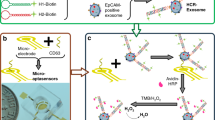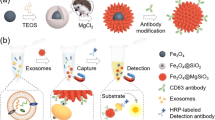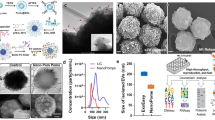Abstract
Exosomes show potential for cancer diagnostics because they transport molecular contents of the cells from which they originate. Detection and molecular profiling of exosomes is technically challenging and often requires extensive sample purification and labeling. Here we describe a label-free, high-throughput approach for quantitative analysis of exosomes. Our nano-plasmonic exosome (nPLEX) assay is based on transmission surface plasmon resonance through periodic nanohole arrays. Each array is functionalized with antibodies to enable profiling of exosome surface proteins and proteins present in exosome lysates. We show that this approach offers improved sensitivity over previous methods, enables portable operation when integrated with miniaturized optics and allows retrieval of exosomes for further study. Using nPLEX to analyze ascites samples from ovarian cancer patients, we find that exosomes derived from ovarian cancer cells can be identified by their expression of CD24 and EpCAM, suggesting the potential of exosomes for diagnostics.
This is a preview of subscription content, access via your institution
Access options
Subscribe to this journal
Receive 12 print issues and online access
$209.00 per year
only $17.42 per issue
Buy this article
- Purchase on Springer Link
- Instant access to full article PDF
Prices may be subject to local taxes which are calculated during checkout




Similar content being viewed by others
References
Théry, C., Ostrowski, M. & Segura, E. Membrane vesicles as conveyors of immune responses. Nat. Rev. Immunol. 9, 581–593 (2009).
Vlassov, A.V., Magdaleno, S., Setterquist, R. & Conrad, R. Exosomes: current knowledge of their composition, biological functions, and diagnostic and therapeutic potentials. Biochim. Biophys. Acta 1820, 940–948 (2012).
Thery, C., Amigorena, S., Raposo, G. & Clayton, A. Isolation and characterization of exosomes from cell culture supernatants and biological fluids. Curr. Protoc. Cell. Biol. 30, 3.22 (2006).
Brolo, A.G. Plasmonics for future biosensors. Nat. Photonics 6, 709–713 (2012).
Gordon, R., Sinton, D., Kavanagh, K.L. & Brolo, A.G. A new generation of sensors based on extraordinary optical transmission. Acc. Chem. Res. 41, 1049–1057 (2008).
Im, H., Wittenberg, N.J., Lesuffleur, A., Lindquist, N.C. & Oh, S.-H. Membraneprotein biosensing with plasmonic nanopore arrays and pore-spanning lipid membranes. Chem. Sci. 1, 688–696 (2010).
Escobedo, C. On-chip nanohole array based sensing: a review. Lab Chip 13, 2445–2463 (2013).
Homola, J. Surface plasmon resonance sensors for detection of chemical and biological species. Chem. Rev. 108, 462–493 (2008).
Lee, H.J., Nedelkov, D. & Corn, R.M. Surface plasmon resonance imaging measurements of antibody arrays for the multiplexed detection of low molecular weight protein biomarkers. Anal. Chem. 78, 6504–6510 (2006).
Campbell, M., Sharp, D.N., Harrison, M.T., Denning, R.G. & Turberfield, A.J. Fabrication of photonic crystals for the visible spectrum by holographic lithography. Nature 404, 53–56 (2000).
Im, H., Lesuffleur, A., Lindquist, N.C. & Oh, S.H. Plasmonic nanoholes in a multichannel microarray format for parallel kinetic assays and differential sensing. Anal. Chem. 81, 2854–2859 (2009).
Yanik, A.A. et al. Seeing protein monolayers with naked eye through plasmonic Fano resonances. Proc. Natl. Acad. Sci. USA 108, 11784–11789 (2011).
Shao, H. et al. Protein typing of circulating microvesicles allows real-time monitoring of glioblastoma therapy. Nat. Med. 18, 1835–1840 (2012).
Tassa, C. et al. Binding affinity and kinetic analysis of targeted small molecule-modified nanoparticles. Bioconjug. Chem. 21, 14–19 (2010).
Anglesio, M.S. et al. Type-specific cell line models for type-specific ovarian cancer research. PLoS ONE 8, e72162 (2013).
Uhlen, M. et al. Towards a knowledge-based human protein atlas. Nat. Biotechnol. 28, 1248–1250 (2010).
Runz, S. et al. Malignant ascites-derived exosomes of ovarian carcinoma patients contain CD24 and EpCAM. Gynecol. Oncol. 107, 563–571 (2007).
Kristiansen, G. et al. CD24 is expressed in ovarian cancer and is a new independent prognostic marker of patient survival. Am. J. Pathol. 161, 1215–1221 (2002).
Bast, R.C. Jr. et al. CA 125: the past and the future. Int. J. Biol. Markers 13, 179–187 (1998).
Canney, P.A., Wilkinson, P.M., James, R.D. & Moore, M. CA19–9 as a marker for ovarian cancer: alone and in comparison with CA125. Br. J. Cancer 52, 131–133 (1985).
Meden, H. & Kuhn, W. Overexpression of the oncogene c-erbB-2 (HER2/neu) in ovarian cancer: a new prognostic factor. Eur. J. Obstet. Gynecol. Reprod. Biol. 71, 173–179 (1997).
Aldovini, D. et al. M-CAM expression as marker of poor prognosis in epithelial ovarian cancer. Int. J. Cancer 119, 1920–1926 (2006).
Psyrri, A. et al. Effect of epidermal growth factor receptor expression level on survival in patients with epithelial ovarian cancer. Clin. Cancer Res. 11, 8637–8643 (2005).
Li, J. et al. Claudin-containing exosomes in the peripheral circulation of women with ovarian cancer. BMC Cancer 9, 244 (2009).
Chu, A.Y., Litzky, L.A., Pasha, T.L., Acs, G. & Zhang, P.J. Utility of D2–40, a novel mesothelial marker, in the diagnosis of malignant mesothelioma. Mod. Pathol. 18, 105–110 (2005).
Kipps, E., Tan, D.S.P. & Kaye, S.B. Meeting the challenge of ascites in ovarian cancer: new avenues for therapy and research. Nat. Rev. Cancer 13, 273–282 (2013).
Valadi, H. et al. Exosome-mediated transfer of mRNAs and microRNAs is a novel mechanism of genetic exchange between cells. Nat. Cell Biol. 9, 654–659 (2007).
Peinado, H. et al. Melanoma exosomes educate bone marrow progenitor cells toward a pro-metastatic phenotype through MET. Nat. Med. 18, 883–891 (2012).
MacBeath, G. & Schreiber, S.L. Printing proteins as microarrays for high-throughput function determination. Science 289, 1760–1763 (2000).
Carey, M.S. et al. Functional proteomic analysis of advanced serous ovarian cancer using reverse phase protein array: TGF-beta pathway signaling indicates response to primary chemotherapy. Clin. Cancer Res. 16, 2852–2860 (2010).
Mudanyali, O. et al. Compact, light-weight and cost-effective microscope based on lensless incoherent holography for telemedicine applications. Lab Chip 10, 1417–1428 (2010).
Palik, E.D. Handbook of Optical Constants of Solids. http://www.sciencedirect.com/science/book/9780125444156 (Elsevier, 1998).
Sheehan, K.M. et al. Use of reverse phase protein microarrays and reference standard development for molecular network analysis of metastatic ovarian carcinoma. Mol. Cell. Proteomics 4, 346–355 (2005).
Skog, J. et al. Glioblastoma microvesicles transport RNA and proteins that promote tumour growth and provide diagnostic biomarkers. Nat. Cell Biol. 10, 1470–1476 (2008).
Yuan, H. et al. Gold nanostars: surfactant-free synthesis, 3D modelling, and two-photon photoluminescence imaging. Nanotechnology 23, 075102 (2012).
Hill, H.D. & Mirkin, C.A. The bio-barcode assay for the detection of protein and nucleic acid targets using DTT-induced ligand exchange. Nat. Protoc. 1, 324–336 (2006).
Acknowledgements
The authors thank S. Skates (Massachusetts General Hospital) for helpful discussion on statistical analyses; M. Birrer for facilitating sample collection; K. Joyes for reviewing the manuscript. This work was supported in part by US National Institutes of Health (NIH) grants R01-HL113156 (H.L.), R01-EB010011 (R.W.), R01-EB00462605A1 (R.W.), T32CA79443 (R.W.), K12CA087723-11A1 (C.M.C) and National Heart, Lung, and Blood Institute contract HHSN268201000044C (R.W.). The device was fabricated using the facilities at the Center for Nanoscale Systems (CNS) at Harvard University (National Science Foundation award ECS-0335765).
Author information
Authors and Affiliations
Contributions
H.I., H.S., R.W. and H.L. designed the research. C.M.C. and R.W. designed the clinical study. H.I., H.S., Y.I.P., V.M.P. and C.M.C. performed the research. V.M.P. and C.M.C. collected the clinical samples. H.I., H.S., R.W. and H.L. analyzed data. H.I., H.S., C.M.C., R.W. and H.L. wrote the paper.
Corresponding authors
Ethics declarations
Competing interests
The authors declare no competing financial interests.
Supplementary information
Supplementary Text and Figures
Supplementary Figures 1–15 and Supplementary Tables 1–4 (PDF 2898 kb)
Rights and permissions
About this article
Cite this article
Im, H., Shao, H., Park, Y. et al. Label-free detection and molecular profiling of exosomes with a nano-plasmonic sensor. Nat Biotechnol 32, 490–495 (2014). https://doi.org/10.1038/nbt.2886
Received:
Accepted:
Published:
Issue Date:
DOI: https://doi.org/10.1038/nbt.2886
This article is cited by
-
A state-of-the-art review of the recent advances in exosome isolation and detection methods in viral infection
Virology Journal (2024)
-
Aptamer-based Membrane Protein Analysis and Molecular Diagnostics
Chemical Research in Chinese Universities (2024)
-
Rapid genetic screening with high quality factor metasurfaces
Nature Communications (2023)
-
Multiplexed analysis of EV reveals specific biomarker composition with diagnostic impact
Nature Communications (2023)
-
Recent progress in exosome research: isolation, characterization and clinical applications
Cancer Gene Therapy (2023)



